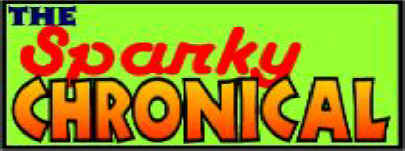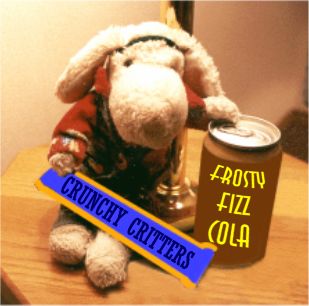| The
Great Cow Uprising
|
|

|
| On our way home in
the morning, we headed out of Chama, toward Antonito, cuz that
seemed to be the shortest way to get out of there and get home.
On the highway we passed many,
many cows, and they was jest meandering down the road, blocking
traffic whenever possible. Some of them took the time to
stare at us until Jim drove around them in the other lane.
They seemed to be heading for
Chama, but wherever they was headed, they was on a mission!
I think they was talking about
going down into town to vandalize the Hamburger Stand, cuz the
rumor got out about where hamburgers come from. It was
reel hard to read those cow lips, but I think that's what they
were talking about.
The bunch in the picture above
was blocking the road completely for about a few minutes, until
several of them got tired of standing there and moved out of the
way, and Jim slowly drove past while the big one that was
looking at us the whole time jest stared at us and turned around
to keep staring at us until we was clear over the next hill!
If you ever go to Chama, watch
out for them, cuz it was clear that they was up to no good, and
if any of them get reel mad, they might jest vandalize your
car!!
|
| Johnnie
Aspenseed
|

|
| On
the train ride we passed a forest that was almost all Aspen
Trees! Millions of them, as far as the eye could see!!!
About 825 years
ago, just after 2:00 in the afternoon, a feller named Johnnie
Aspenseed was riding his horse looking for a place to plant 8 or
7 Aspen Tree seeds, when his horse, who had been in a bad mood
all day, did a wheelie and threw him off. His big bag of
seeds fell to the ground and the wind blew the seeds all over
the place. That's why there are so many Aspen Trees in
that area.
He had a cousin
named Johnnie Appleseed, who planted apple trees and another
cousin named Johnnie Weedseed, who planted weeds.
|
|
|

|
Sparky's
Colorado Vacation, Page 6
by Sparky |
| Cumbres
& Toltec Gorge Scenic Railroad
August 17,
2003.
We got up at the
crack of dawn and the old folks went back to the Branding Iron
Restaurant for breakfast. Us guys stayed in the room and
munched on some goodies we found in the small ice cooler we take
along on trips.
After breakfast and
after us guys voted on who was going to go on the train ride, me,
(Sparky), Ty, Sniffy and Lil Benny wound up being the guys who was
gonna go on that train ride, so we crawled into the bag that we
use so the old folks can take us along without buying any extra
tickets.
When we got to the
train station, we got onto a big bus, shown in photo #1, that took
us to Antonito, Colorado, which is where the train starts from, to
take us back to Chama. The old folks had to take turns
acting like tourists, and taking pictures of each other standing in
front of the locomotive. Us guys didn't really want to be in
a picture like that, but Jim made Sparky join in, and you can just
see him in Jim's hand if you click on picture #3 to make it
bigger.
Photo #4 shows the
locomotive fireman refilling the tender water tank so we don't run
out of water while climbing the big hill up to the top at Cumbres
Pass. Locomotives like this leak a lot of water out of all
sorts of places, so it's no wonder that they need to refill them
every 25 miles or so with about several million gallons of
water. I was thinking about telling the train driver that he
should put some buckets under all of those leaky pipes, but I sort
of got into trubble before I could tell him (See photo #7).
Photo #5 shows us
chugging up a long hill, and water was leaking all over the place
and steam was squirting out of a lot of different pipes and other
funny looking things that I could see by just looking out of the
window.
Photo #6 shows all
of us sitting on the back of the tender just after the old folks
had finished eating lunch at Osier.
Photo #7 shows how
the conductor caught me checking out that locomotive and I was
getting ready to pull the string that makes the whistle
blow. He shook me reel good and was gonna throw me into the
dirty coal pile in the tender, but the old folks rescued me and it
turned out okay. That's when I decided not to tell them how
to save all that wasted water.
Photo #8 shows our
parlor car hostess, Breean, who caught me after I had sneaked into
that car during lunch and was trying to get us guys some lunch,
cuz that cafeteria at Osier was so busy with people we was all
scared of getting stepped on or left behind if the train took
off. Breean was reel nice to us, and she gave me a root beer
and gave Sniffy a Cheese Danish, so we all shared it and got reel
full. Photo #9 shows that Cheese Danish, and it sure was
GOOD!
|
| Cumbres
& Toltec Gorge Railroad Photo Album |
|

1. Bus to Antonito, Colo.
|

2. Gloria checking out locomotive
|

3. Jim & Sparky re-checking it
|

4. Refilling the tender water tank
|
|

5. Chugging up the hill
|

6. Us guys on the locomotive tender
|

7. Sparky nabbed by conductor
|

8. Sparky nabbed by hostess
|

9. Sparky & Sniffy ready for lunch |

10. Lunch servers at Osier |

11. Old lumber pile at Osier |

12. Scary trestle just past Osier |
|

13. Crazy horses racing around
|

14. Station at Cumbres Pass
|

15. Bulletin board at Cumbres Pass
|

16. Our parlor car behind locomotive
|
|
|
Photo #10 shows all
the lunch workers that served everybuddy at Osier, waving to us as
the train pulled out after lunch.
Photo #11 shows a
pile of valuable antique wood near Osier.
A reel scary
trestle is shown in photo #12. If you look closely at the
little picture at right you can see that there is a little train
thingy that follows the big train. Its job is to pick up any hats or
other things that fall out of the train. Also, they pick up
all the people who fall out of the open cars at the rear of the
train, and every time the train stops for water or lunch or
something, they can then load them back into the train to try
again. They also have a water tank in case any coal embers
start a little fire in the weeds along the tracks.
follows the big train. Its job is to pick up any hats or
other things that fall out of the train. Also, they pick up
all the people who fall out of the open cars at the rear of the
train, and every time the train stops for water or lunch or
something, they can then load them back into the train to try
again. They also have a water tank in case any coal embers
start a little fire in the weeds along the tracks.
In photo #13 you
can see some horses racing around. When they saw the train,
the engineer blew the whistle, and they all started racing around
and around in a large field that the tracks looped around.
They kept racing in circles until the train was pretty far
away. The conductor said they do that every time the train
gets near them.
Photos #14 and #15
show the train station at Cumbres Pass.
Photo #16 shows our
train back in Chama. The pretty red parlor car is the one we
rode in, and because it was close to the engine, we didn't get
very many hot coals on us inside, cuz they mostly squirt up with
all the smoke and end up all over the people in the cars farther
toward the back.
Be sure to click on
the website for more information about the railroad:
Cumbres
& Toltec Gorge Scenic Railroad
That was pretty
much it. We spent the night at the motel, then left for home
in the morning. Except for the Big Cattle Uprising we saw on
the way home, as explained in the column at left.
We was gonna ride
another train in Leadville, but everybuddy was getting tired and
cranky, so we jest kept on going.
Anyhow, it was jest
a Diesel train, and Jim said that if he wanted to take a ride in a
Diesel vehicle, he can jest go over to Gloria's brother Chuck's
house and get a ride in his Ford pickup.
|
|
| Steam
Locomotive & Railroad Factoids
The steam
locomotives used by both the Cumbres & Toltec Gorge Scenic
Railroad and the Durango & Silverton Narrow Gauge Railroad
weigh between 75 and 80 tons.
Earlier steam
locomotives from the 1840's weighed from 10 to 20 tons. The
heaviest steam locomotive ever built, the "Big Boy,"
weighs in at an incredible 1.2 million
pounds, and puts out 6,200 horsepower!
|

|
| The
Big Boy Locomotive above, #4012, is now on display at Steamtown
National Park, in Scranton, Pennsylvania. Click below on these
websites for more information.
Steamtown
Park
Big
Boy Locomotive
At least one more Big Boy is on
display at the Forney Museum in Denver, and you can find out
more by clicking here:
Forney
Museum
|
| The Big Boy and many
other of the newer steam locomotives burned oil rather than
coal. Oil was cleaner and more efficient to use and there
were no ash or cinders to worry about.
Some late model coal burners
utilized steam to blow coal into the 20-foot- long firebox,
because a man with a shovel couldn't easily throw heavy shovels
full of coal far enough to enable the fire to spread out and
burn evenly.
Water was always a problem.
Large locomotives pulling heavy trains normally had to stop
every 50 miles or so to take on water. In winter, steam
was piped to the water tank in the sides of the tender to keep
things from freezing up.
In the west, where distances were
great and water stops caused a great loss of time, mile-long
water pans or trays were installed between and below the rails
so the locomotive could lower a snorkel into the pan and draw
water into its tank while speeding along.
Narrow Gauge vs.
Standard Gauge
Standard Gauge is
considered to be 4' 8-1/2" between
the rails, while most Colorado mountain railroads used 3'
gauge.
Narrow gauge tracks allow sharper
curves for traversing mountain terrain, at the sacrifice of
stability...the trains typically travel 10 to 15 mph, and rock
and roll severely at times.
Standard Gauge enables higher
speeds and greater stability due to the wider wheel span.
|
|

